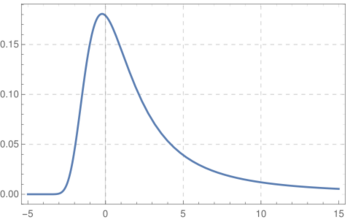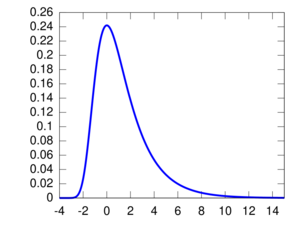Landau distribution
|
Probability density function  [math]\displaystyle{ \mu=0,\; c=\pi/2 }[/math] | |||
| Parameters |
[math]\displaystyle{ c \in(0,\infty) }[/math] — scale parameter | ||
|---|---|---|---|
| Support | [math]\displaystyle{ \mathbb{R} }[/math] | ||
| [math]\displaystyle{ \frac{1}{\pi c}\int_0^\infty e^{-t}\cos\left(t\left(\frac{x-\mu}{c}\right) + \frac{2t}{\pi}\log\left(\frac{t}{c}\right)\right)\, dt }[/math] | |||
| Mean | Undefined | ||
| Variance | Undefined | ||
| MGF | Undefined | ||
| CF | [math]\displaystyle{ \exp\left(it\mu -\frac{2ict}{\pi}\log|t| - c|t|\right) }[/math] | ||
In probability theory, the Landau distribution[1] is a probability distribution named after Lev Landau. Because of the distribution's "fat" tail, the moments of the distribution, like mean or variance, are undefined. The distribution is a particular case of stable distribution.
Definition
The probability density function, as written originally by Landau, is defined by the complex integral:
- [math]\displaystyle{ p(x) = \frac{1}{2 \pi i} \int_{a-i\infty}^{a+i\infty} e^{s \log(s) + x s}\, ds , }[/math]
where a is an arbitrary positive real number, meaning that the integration path can be any parallel to the imaginary axis, intersecting the real positive semi-axis, and [math]\displaystyle{ \log }[/math] refers to the natural logarithm. In other words it is the Laplace transform of the function [math]\displaystyle{ s^s }[/math].
The following real integral is equivalent to the above:
- [math]\displaystyle{ p(x) = \frac{1}{\pi} \int_0^\infty e^{-t \log(t) - x t} \sin(\pi t)\, dt. }[/math]
The full family of Landau distributions is obtained by extending the original distribution to a location-scale family of stable distributions with parameters [math]\displaystyle{ \alpha=1 }[/math] and [math]\displaystyle{ \beta=1 }[/math],[2] with characteristic function:[3]
- [math]\displaystyle{ \varphi(t;\mu,c)=\exp\left(it\mu -\tfrac{2ict}{\pi}\log|t|-c|t|\right) }[/math]
where [math]\displaystyle{ c\in(0,\infty) }[/math] and [math]\displaystyle{ \mu\in(-\infty,\infty) }[/math], which yields a density function:
- [math]\displaystyle{ p(x;\mu,c) = \frac{1}{\pi c}\int_{0}^{\infty} e^{-t}\cos\left(t\left(\frac{x-\mu}{c}\right)+\frac{2t}{\pi}\log\left(\frac{t}{c}\right)\right)\, dt , }[/math]
Taking [math]\displaystyle{ \mu=0 }[/math] and [math]\displaystyle{ c=\frac{\pi}{2} }[/math] we get the original form of [math]\displaystyle{ p(x) }[/math] above.
Properties
- Translation: If [math]\displaystyle{ X \sim \textrm{Landau}(\mu,c)\, }[/math] then [math]\displaystyle{ X + m \sim \textrm{Landau}(\mu + m ,c) \, }[/math].
- Scaling: If [math]\displaystyle{ X \sim \textrm{Landau}(\mu,c)\, }[/math] then [math]\displaystyle{ aX \sim \textrm{Landau}(a\mu-\tfrac{2ac\log(a)}{\pi}, ac) \, }[/math].
- Sum: If [math]\displaystyle{ X \sim \textrm{Landau}(\mu_1, c_1) }[/math] and [math]\displaystyle{ Y \sim \textrm{Landau}(\mu_2, c_2) \, }[/math] then [math]\displaystyle{ X+Y \sim \textrm{Landau}(\mu_1+\mu_2, c_1+c_2) }[/math].
These properties can all be derived from the characteristic function. Together they imply that the Landau distributions are closed under affine transformations.
Approximations
In the "standard" case [math]\displaystyle{ \mu=0 }[/math] and [math]\displaystyle{ c=\pi/2 }[/math], the pdf can be approximated[4] using Lindhard theory which says:
- [math]\displaystyle{ p(x+\log(x)-1+\gamma) \approx \frac{\exp(-1/x)}{x(1+x)}, }[/math]
where [math]\displaystyle{ \gamma }[/math] is Euler's constant.
A similar approximation [5] of [math]\displaystyle{ p(x;\mu,c) }[/math] for [math]\displaystyle{ \mu=0 }[/math] and [math]\displaystyle{ c=1 }[/math] is:
- [math]\displaystyle{ p(x) \approx \frac{1}{\sqrt{2\pi}}\exp\left(-\frac{x + e^{-x}}{2}\right). }[/math]
Related distributions
- The Landau distribution is a stable distribution with stability parameter [math]\displaystyle{ \alpha }[/math] and skewness parameter [math]\displaystyle{ \beta }[/math] both equal to 1.
References
- ↑ Landau, L. (1944). "On the energy loss of fast particles by ionization". J. Phys. (USSR) 8: 201. http://e-heritage.ru/Book/10093344.
- ↑ Gentle, James E. (2003). Random Number Generation and Monte Carlo Methods. Statistics and Computing (2nd ed.). New York, NY: Springer. p. 196. doi:10.1007/b97336. ISBN 978-0-387-00178-4.
- ↑ Zolotarev, V.M. (1986). One-dimensional stable distributions. Providence, R.I.: American Mathematical Society. ISBN 0-8218-4519-5. https://archive.org/details/onedimensionalst00zolo_0.
- ↑ "LandauDistribution—Wolfram Language Documentation". https://reference.wolfram.com/language/ref/LandauDistribution.html.
- ↑ Behrens, S. E.; Melissinos, A.C.. Univ. of Rochester Preprint UR-776 (1981).
 |


